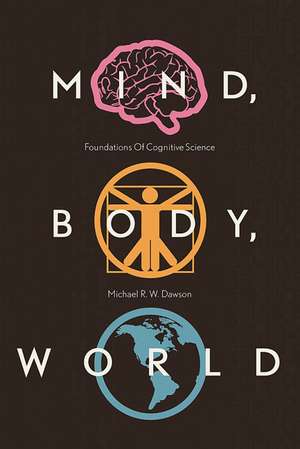Mind, Body, World: Foundations of Cognitive Science: OPEL: Open Paths to Enriched Learning
Autor Michael R.W. Dawsonen Limba Engleză Paperback – 15 iul 2013
Cognitive science arose in the 1950s when it became apparent that a number of disciplines, including psychology, computer science, linguistics, and philosophy, were fragmenting. Perhaps owing to the field’s immediate origins in cybernetics, as well as to the foundational assumption that cognition is information processing, cognitive science initially seemed more unified than psychology. However, as a result of differing interpretations of the foundational assumption and dramatically divergent views of the meaning of the term information processing, three separate schools emerged: classical cognitive science, connectionist cognitive science, and embodied cognitive science.
Examples, cases, and research findings taken from the wide range of phenomena studied by cognitive scientists effectively explain and explore the relationship among the three perspectives. Intended to introduce both graduate and senior undergraduate students to the foundations of cognitive science, Mind, Body, World addresses a number of questions currently being asked by those practicing in the field: What are the core assumptions of the three different schools? What are the relationships between these different sets of core assumptions? Is there only one cognitive science, or are there many different cognitive sciences? Giving the schools equal treatment and displaying a broad and deep understanding of the field, Dawson highlights the fundamental tensions and lines of fragmentation that exist among the schools and provides a refreshing and unifying framework for students of cognitive science.
Examples, cases, and research findings taken from the wide range of phenomena studied by cognitive scientists effectively explain and explore the relationship among the three perspectives. Intended to introduce both graduate and senior undergraduate students to the foundations of cognitive science, Mind, Body, World addresses a number of questions currently being asked by those practicing in the field: What are the core assumptions of the three different schools? What are the relationships between these different sets of core assumptions? Is there only one cognitive science, or are there many different cognitive sciences? Giving the schools equal treatment and displaying a broad and deep understanding of the field, Dawson highlights the fundamental tensions and lines of fragmentation that exist among the schools and provides a refreshing and unifying framework for students of cognitive science.
Preț: 392.20 lei
Nou
Puncte Express: 588
Preț estimativ în valută:
75.05€ • 77.85$ • 62.58£
75.05€ • 77.85$ • 62.58£
Carte indisponibilă temporar
Doresc să fiu notificat când acest titlu va fi disponibil:
Se trimite...
Preluare comenzi: 021 569.72.76
Specificații
ISBN-13: 9781927356173
ISBN-10: 1927356172
Pagini: 520
Dimensiuni: 178 x 254 x 33 mm
Greutate: 0.97 kg
Ediția:New.
Editura: University of British Columbia Press
Colecția Athabasca University Press
Seria OPEL: Open Paths to Enriched Learning
ISBN-10: 1927356172
Pagini: 520
Dimensiuni: 178 x 254 x 33 mm
Greutate: 0.97 kg
Ediția:New.
Editura: University of British Columbia Press
Colecția Athabasca University Press
Seria OPEL: Open Paths to Enriched Learning
Cuprins
List of Figures and Tables | ix
Preface | xiii
Who Is This Book Written For? | xiv
Acknowledgements | xv
Chapter 1. The Cognitive Sciences: One or Many? | 1
1.0 Chapter Overview | 1
1.1 A Fragmented Psychology | 2
1.2 A Unified Cognitive Science | 3
1.3 Cognitive Science or the Cognitive Sciences? | 6
1.4 Cognitive Science: Pre-paradigmatic? | 13
1.5 A Plan of Action | 16
Chapter 2. Multiple Levels of Investigation | 19
2.0 Chapter Overview | 19
2.1 Machines and Minds | 20
2.2 From the Laws of Thought to Binary Logic | 23
2.3 From the Formal to the Physical | 29
2.4 Multiple Procedures and Architectures | 32
2.5 Relays and Multiple Realizations | 35
2.6 Multiple Levels of Investigation and Explanation | 38
2.7 Formal Accounts of Input-Output Mappings | 40
2.8 Behaviour by Design and by Artifact | 41
2.9 Algorithms from Artifacts | 43
2.10 Architectures against Homunculi | 46
2.11 Implementing Architectures | 48
2.12 Levelling the Field | 51
Chapter 3. Elements of Classical Cognitive Science | 55
3.0 Chapter Overview | 55
3.1 Mind, Disembodied | 56
3.2 Mechanizing the Infinite | 59
3.3 Phrase Markers and Fractals | 65
3.4 Behaviourism, Language, and Recursion | 68
3.5 Underdetermination and Innateness | 72
3.6 Physical Symbol Systems | 75
3.7 Componentiality, Computability, and Cognition | 78
3.8 The Intentional Stance | 82
3.9 Structure and Process | 85
3.10 A Classical Architecture for Cognition | 89
3.11 Weak Equivalence and the Turing Te
Preface | xiii
Who Is This Book Written For? | xiv
Acknowledgements | xv
Chapter 1. The Cognitive Sciences: One or Many? | 1
1.0 Chapter Overview | 1
1.1 A Fragmented Psychology | 2
1.2 A Unified Cognitive Science | 3
1.3 Cognitive Science or the Cognitive Sciences? | 6
1.4 Cognitive Science: Pre-paradigmatic? | 13
1.5 A Plan of Action | 16
Chapter 2. Multiple Levels of Investigation | 19
2.0 Chapter Overview | 19
2.1 Machines and Minds | 20
2.2 From the Laws of Thought to Binary Logic | 23
2.3 From the Formal to the Physical | 29
2.4 Multiple Procedures and Architectures | 32
2.5 Relays and Multiple Realizations | 35
2.6 Multiple Levels of Investigation and Explanation | 38
2.7 Formal Accounts of Input-Output Mappings | 40
2.8 Behaviour by Design and by Artifact | 41
2.9 Algorithms from Artifacts | 43
2.10 Architectures against Homunculi | 46
2.11 Implementing Architectures | 48
2.12 Levelling the Field | 51
Chapter 3. Elements of Classical Cognitive Science | 55
3.0 Chapter Overview | 55
3.1 Mind, Disembodied | 56
3.2 Mechanizing the Infinite | 59
3.3 Phrase Markers and Fractals | 65
3.4 Behaviourism, Language, and Recursion | 68
3.5 Underdetermination and Innateness | 72
3.6 Physical Symbol Systems | 75
3.7 Componentiality, Computability, and Cognition | 78
3.8 The Intentional Stance | 82
3.9 Structure and Process | 85
3.10 A Classical Architecture for Cognition | 89
3.11 Weak Equivalence and the Turing Te
